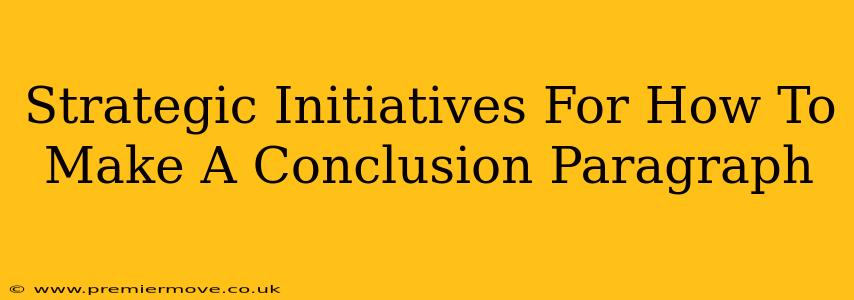The conclusion. It's the final curtain call, the last impression you leave on your reader. A weak conclusion can unravel even the strongest argument, leaving your audience feeling unsatisfied and unfulfilled. But a strong conclusion? That's the stuff of memorable essays, impactful presentations, and persuasive writing. Let's explore some strategic initiatives to elevate your conclusion paragraphs from "meh" to "magnificent."
Beyond the Summary: Reimagine Your Conclusion
Forget the tired, repetitive summary. Your conclusion isn't just a regurgitation of what you've already said. Instead, think of it as a powerful synthesis of your ideas, a crescendo that leaves a lasting impact.
Strategic Approaches to Conclusion Writing
-
The "So What?" Factor: Your conclusion should directly address the "so what?" question. Why should your reader care about what you've presented? What are the implications? What's the takeaway? This is where you solidify the value and relevance of your work.
-
Call to Action (Where Appropriate): For persuasive writing, a call to action is crucial. Don't just tell your reader something; tell them what to do with that information. This could be anything from making a purchase to taking a specific action or simply continuing to learn.
-
Thought-Provoking Questions: Instead of a conclusive statement, end with a question that sparks further reflection and discussion. This leaves your reader engaged long after they've finished reading.
-
The "Forward-Looking" Approach: Project your ideas into the future. What are the potential consequences of your findings? What might happen next? This adds a layer of intrigue and demonstrates your insightful understanding of the topic.
-
A Powerful, Memorable Closing Sentence: This is your final chance to leave a lasting impression. Craft a sentence that encapsulates the essence of your argument or leaves the reader with a powerful image or thought.
Avoiding Common Conclusion Pitfalls
Many writers fall into common traps when crafting their conclusions. Let's address these to help you avoid them:
-
Introducing New Information: Never introduce entirely new information in your conclusion. This is jarring and disrupts the flow.
-
Apologizing for your Work: Avoid phrases like "I know this isn't perfect" or "I hope this was helpful." Confidence is key!
-
Being Too Vague or General: Your conclusion should be precise and directly relate to your thesis statement. Avoid vague generalizations that leave the reader unsure of your main points.
-
Ending Abruptly: A sudden stop can leave your reader feeling unsatisfied. Ensure a smooth and logical transition from the body paragraphs to your conclusion.
Conclusion: Mastering the Art of the Final Paragraph
Crafting a strong conclusion is a skill that improves with practice. By understanding the strategic approaches and avoiding common pitfalls, you can transform your conclusion from a mere afterthought to a powerful and memorable element of your writing. Remember, your conclusion isn't just an ending; it's a powerful statement that leaves a lasting impact. So, go forth and write conclusions that captivate and inspire!

